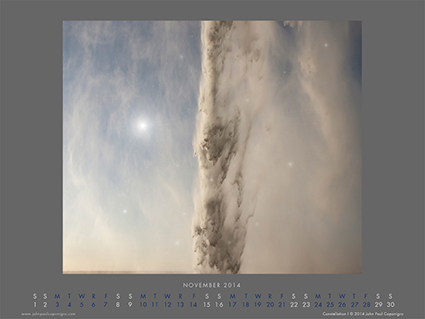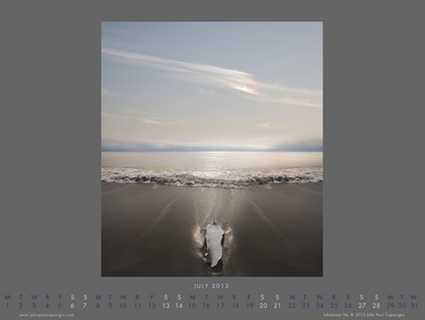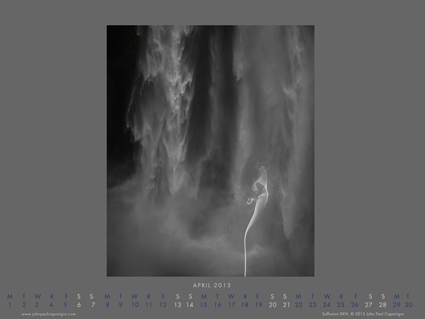Free December Desktop Calendar
 My free December 2014 Desktop Calendar features a new image from Jokulsarlon, Iceland.
My free December 2014 Desktop Calendar features a new image from Jokulsarlon, Iceland.
Download it here.
 My free December 2014 Desktop Calendar features a new image from Jokulsarlon, Iceland.
My free December 2014 Desktop Calendar features a new image from Jokulsarlon, Iceland.
Download it here.

My free November 2014 Desktop Calendar features a new image from Seljalandsfoss, Iceland.
Download it here.
There were many surprises on our recent DPD workshop in Iceland. Anticipating auroras we encountered heavy weather, which we expertly dodged with resourcefulness of our hosts at Focus On Nature.
In the images I made during this week I found something old and something new. I revisited a few old themes – reflections and ripples. I connected new themes – contrails and tire tracks. But the bird’s eye views we saw during one hour of aerials both over frozen highlands and along flowing rivers were the most captivating. Related to aerial images I’ve produced in Namibia, I’m sure now that this kind of photography is something I’ll do much more of in the future.
That said, it’s really the relationship between a new image of a wave and an earlier one of a waterfall that excites me most. I thought that I hadn’t found what I was looking for, great images of auroras. But when I saw this wave repeatedly crashing into the air, I realized I actually found what I’d been looking for for quite some time. Expect the unexpected?
View more Contact Sheets here.
View Seth Resnick’s images from the same voyage here.
Learn more about my digital printing and digital photography workshops.
Suffusion XV, Skogafoss, Iceland, 2012
To find what I was looking for, it took three visits to this waterfall.
On the first visit, I made conventional postcards surveying the site with a curious eye: cliffs, grass, moss, waterfall, pool, river, rock, vapor, rainbow, sun, clouds, rain, tourists, and horses. The images I made were competent – and nothing more.
On the second visit, I identified my primary focus – the fast-moving complex patterns the water made as it fell in waves through the air. Images that isolated these patterns contained a number of qualities that I was excited about, both something related to what I had been developing in other images and something new. I had found what I was looking for. But, when I evaluated the images I made and developed the material further (enhancing the patterns by combining them and adding new elements), it became clear that I needed more material to make a complete statement. During development, I made notes and sketches to chart my progress and refine my ideas.
On the third visit, I walked up to the waterfall and stood in front of it, silently watching for new patterns and making exposures for the better part of an hour. I was thrilled to be immersed in a magical moment, completely focused and undisturbed. At the end of this session, my good friend and colleague Arthur Meyerson asked, “Did you get anything?” “Yes,” I responded, “I got a body of work.”
With so many wonderful possibilities out there, why would you return to the same well more than once? Let me count the reasons.
1 You’ll get to spend more time with your favorite people, places, or things.
Passion energizes.
2 You’ll have an opportunity to make the images that almost worked or that you missed.
Make a list to learn from your mistakes and create a working plan.
3 You’ll have an opportunity to improve your images.
Practice makes perfect.
4 You’ll learn more about a place.
By increasing your understanding of the places you photograph, your photographs will become more interesting.
5 You’ll see changes in the place.
Time reveals new things, changing subjects and changing us.
6 You’ll see new things.
Having first found the images that come to you naturally, you’ll later find yourself challenged to look for other kinds of images, which will stimulate your creativity and increase your visual versatility.
7 You’ll learn more about yourself. You’ll be called to identify your habits, changes, strengths and weaknesses, hopes and purpose.
Just because we see new things doesn’t mean we will see in new ways. In fact, it’s often during times when we are engaged by a great deal of new information that we fall back on our habits. When we see the same things again, we are challenged to see in new ways and/or deepen the ways we see them.
Questions
What things would be most valuable for you to revisit?
How many new ways can you imagine approaching a subject?
What do you hope to accomplish when you revisit them?
What can you learn about yourself when you return – preferences, tendencies, habits, core strengths, areas for improvement, etc.?
Oriens
Updated 2013
This is a selection of my top 12 images of all time. This selection doesn’t reflect sales, publication, or activities on the world wide web. It simply reflects my opinion. Click on the titles to find out more about each image.
Geography
Read The Most Sublime Landscape Experiences Of My Life here.
Process
20% straight. 80% composites.
Poetry, by any means necessary.
Experiment to find out what’s possible.
Concepts
A profound shift in consciousness arises when we relate to the world (all of it) as parts of a living thing into whose fibers we are deeply woven before birth and after death. Just as every individual has a unique spirit, every location has its own unique spirit (Genius loci is the latin translation of what the Greeks called this.), which fits into the larger world spirit (Anima mundi is the latin translation of what the Greeks called this.) We are not apart from nature, we are a part of Nature.
Magnificent Moment
Read about the most Sublime Moments of my life here.
View more of my Annual Top 12 Selections here.
Constellation VI, Selljalandsfoss, Iceland, 2012
I had tried my hand at this subject and failed a number of times. It was easy to make the standard high-impact postcard images of this famous location. Selljalandsfoss, Iceland is a marvelous waterfall that you can circle in front of, around, behind and back again. It’s particularly dramatic in the winter when the stairs that lead behind it freeze over and the walls around it freeze up forming icy stalactites of all sizes that periodically crash to the ground. It’s particularly divine on evenings when the setting sun sets the sky and the waterfall afire. In all the times I’ve visited Selljalandsfoss, the light has been like this only twice. Good enough results the first time lead to my knowing what I needed to do to excel – and I was able to do it. Well before sunset, I walked behind the waterfall, and sat quietly without interruption for the better part of two hours, listening to the thundering sound of the cascading water, feeling its vibrations in my body, and watching the water slowly change color from white, to cream, to gold, to pink, to coral, to mauve, to lavender, to gray, to black. I never took my eyes off the water, seeing endless patterns continually appearing, disappearing, and reappearing. I was enthralled, enchanted, transported in one of the more intensely inspiring moments of my life. I made a thousand exposures and collected enough material for a body of work. When you’re in the zone you stay there and you don’t do anything that might disrupt your flow.
What specifically is flow? A mental state when people are completely absorbed with energized focus while harnessing emotions aligned with performing and learning activities. Some say that how and when flow happens is a mystery; they give up on solving this riddle because there are so many conditions that contribute to failing to achieve, sustain, and disrupt flow – and they vary between individuals and individual moments. Others love mysteries, like flow; they look to the most common causes for achieving and sustaining flow and incorporate individual differences and sensitivity to current conditions into attempts to achieve and maintain it. Psychologist Mihaly Csikszentmihalyi suggests that we enter states of flow or peak performance when we rise to challenges that interest and stretch us but aren’t beyond our ability to meet, placing us in a curious emotional state that lies between the poles of boredom and anxiety. Throughout the ages, cultures have studied flow (using many different names) and we continue to learn more and more about it every day. My recommendation is that you, too, study flow – personally.
For instance, from previous experiences, I know I tend to achieve states of flow more frequently and more deeply when I connect with a subject emotionally and my understanding of it is deep enough to ask more specific questions while creating something in a way that involves physical activity with sustained concentration. The natural world is almost always involved in some way. Reflection before, meditation during, and contemplation after all aid this process for me.
You can profit from other people’s experiences of flow, what they create in it, and the paths they find to it, but don’t expect yours to be identical – your experience may be very different. In your study of flow, beware of limiting attitudes and superstitious behavior. Above all, pursue flow actively. Take action. Don’t ask, “What happens if …?” hypothetically and preemptively. Instead, ask “What happens when … ?” during practical experimentation. Then, look at probabilities and stack them in your favor. All you need to do is to find your tipping point(s) and trigger them. How do you know when you’re in the zone? You’ll know. And so will everyone else. When you’re in the zone, there’s no denying it. You’re usually there when you’re doing your best work and feel most alive.
Questions
What are the benefits of being in the zone?
How do you know when you’re in the zone?
What does it take for you to get into the zone?
What can you do to get into the zone faster?
What can you do to get into the zone more frequently?
What can you do to stay in the zone longer?
Find out more about this image here.

My free July desktop calendar features an image from Iceland.
Download it here now.
Find out about upcoming events here.

My free April desktop calendar features an image in my series Suffusion from Iceland.
Download it here now.
Find out about upcoming events here.

My free March desktop calendar features an image from Iceland.
Download it here now.
Find out about upcoming events here.
How do aurora work? Find out in this informative video.
Learn more in my Iceland Aurora digital photography workshop.